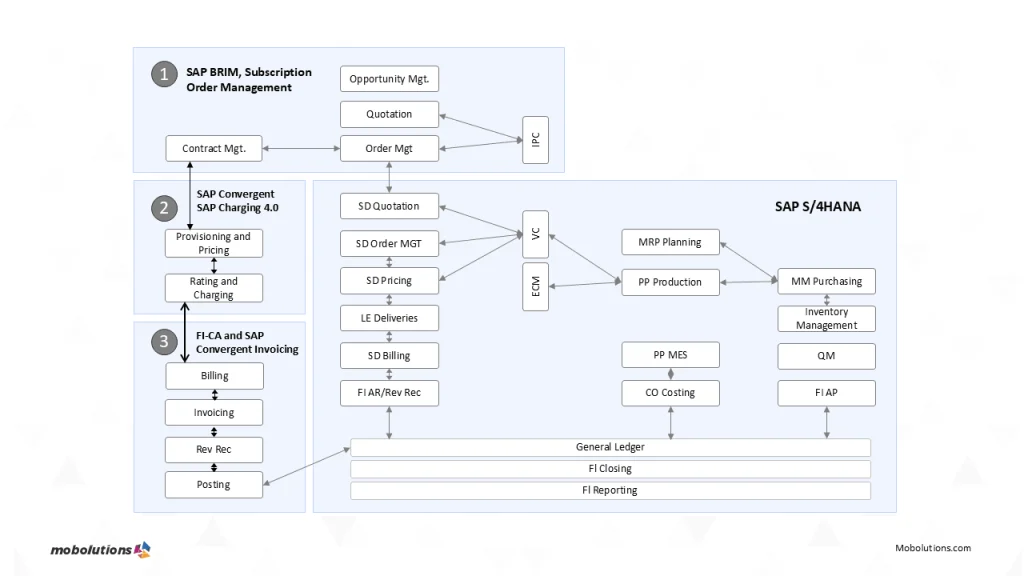The difference between SAP BRIM Convergent Invoicing (CI) and traditional invoicing systems becomes especially significant when handling complex billing environments, such as subscription services, usage-based charges, or high-volume transactions. Traditional invoicing systems typically generate separate invoices for each service or product, often leading to fragmented billing, higher error rates, and less visibility into the overall customer account. In contrast, SAP BRIM’s Convergent Invoicing consolidates all charges—recurring subscriptions, usage-based fees, one-time charges – into a single, unified invoice.
This streamlined approach not only simplifies billing for businesses but also enhances the customer experience by providing clear, transparent, and accurate invoices. Throughout this blog, we’ll explore key differences in capabilities, scalability, compliance, and operational efficiency between SAP BRIM CI and traditional invoicing methods, helping you understand why modern businesses increasingly adopt convergent invoicing to stay competitive.
What Is SAP BRIM Convergent Invoicing?
SAP BRIM (Billing and Revenue Innovation Management) is designed for companies with usage-based, subscription-based, or multi-service offerings.
Convergent Invoicing is the component that brings together multiple billing streams (e.g., product sales, usage charges, subscriptions) into one consolidated invoice.
Key Differences
Multi-Service and Usage-Based Billing
SAP BRIM Convergent Invoicing:
- Designed to handle multiple billing sources: telecom, utilities, media, subscription services, etc.
- Consolidates usage data, subscriptions, and one-time charges into one invoice per customer.
Traditional Invoicing Systems:
- Typically handles simple, single-source billing.
- Each service/product may generate separate invoices, leading to fragmentation.
Real-Time Charging and Rating
BRIM CI:
- Supports real-time rating and charging (essential for services like data usage, pay-per-use).
- Works with SAP Convergent Charging’s flexible pricing models.
Traditional Systems:
- Usually batch-based and not designed for real-time pricing or complex rating.
- Not suitable for high-frequency usage data.
Invoice Consolidation and Customer Experience
BRIM CI:
- Merge all charges from various services into one clear invoice.
- Enhances customer transparency and reduces confusion.
Traditional Invoicing:
- Customers may receive multiple invoices for different services or billing cycles.
- Can be inefficient and frustrating, especially in subscription-heavy models.
Flexibility in Billing Models
BRIM CI:
- Supports prepaid, postpaid, recurring, and usage-based billing—all in one system.
- Ideal for industries shifting to subscription models (e.g., telecom, SaaS, digital media).
Traditional Systems:
- Often rigid, either built for product-based billing or simple recurring billing.
- Not easily adaptable to hybrid or dynamic pricing models.
Scalability and Performance
BRIM CI:
- Built for massive transaction volumes, such as millions of customer records or usage events per day.
- Highly scalable with cloud-ready architecture (S/4HANA compatibility).
Traditional Systems:
- Performance may degrade under high-volume or complex invoicing needs.
- Limited support for horizontal scaling.
SAP Convergent Invoicing is the central hub that:
- Aggregates billable items from multiple upstream systems (e.g., usage, subscriptions, one-time orders).
- Generates a single invoice per customer or contract, improving transparency and customer satisfaction.
- Connects seamlessly with financial accounting (FI-CA) for collections, payments, and dunning.
CI Process Flow Summary:
- Data Collection: Collects rated events and billing data from CC, SOM, etc.
- Billable Items Creation: Creates and stores billable items in the CI staging area.
- Invoicing: Aggregates and groups items per customer or contract.
- Invoice Output: Generates invoices in PDF/XML formats and distributes them.
- FI-CA Integration: Posts the invoices to SAP FI-CA for financial follow-up.
Benefits of Using CI:
- Unified Billing Experience: One invoice across all services.
- High-volume Scalability: Ideal for industries with millions of transactions (e.g., telecom, utilities).
- Reduced Operational Cost: Streamlined processes and automation.
- Improved Accuracy: Fewer billing disputes due to integrated and validated processes.
- Real-Time Processing: Supports on-demand invoicing and analytics.
| Feature / Capability | SAP BRIM Convergent Invoicing | Traditional Invoicing Systems |
| Billing Model Support | Complex models: subscription, usage-based, hybrid | Primarily one-time or recurring |
| Industry Fit | Telecom, utilities, media, cloud, transportation | General retail, manufacturing, basic services |
| Volume Handling | Designed for high-volume, high-frequency transactions | Limited scalability in mass/real-time processing |
| Integration with Upstream Systems | Deep integration with Convergent Charging, SOM, FI-CA | Usually limited or point-to-point integrations |
| Revenue Sharing & Partner Settlements | Built-in partner revenue sharing & intercompany billing | Typically requires customization or third-party tools |
| Invoice Consolidation | Combines multiple charges into a single invoice | Often issues multiple invoices per service type |
| Customization and Flexibility | Highly customizable per customer/account | Often rigid; custom logic requires heavy IT support |
| Real-Time Capabilities | Supports real-time rating and re-rating | Mostly batch-based, delayed processing |
| Error Handling & Reversal | Advanced capabilities with audit trail | Manual corrections, often lacking full traceability |
| Compliance & Taxation | Global compliance support (e.g., VAT, digital tax rules) | Basic compliance; limited multi-country support |
| Customer Experience | Consistent, single invoice for complex product bundles | Fragmented billing leads to customer confusion |
| Integration with Financials | Seamless with SAP FI-CA and S/4HANA Financials | May need bridging integrations to ERP/accounting systems |
Industry Use Cases
SAP Convergent Invoicing is particularly beneficial for industries with complex billing requirements:
- Telecommunications: Managing charges for voice, data, and value-added services.
- Utilities: Billing for electricity, water, and gas consumption.
- Cloud Services: Handling subscription and usage-based billing for cloud platforms.
CONCLUSION:
CI acts as a billing hub that aggregates data from SAP Convergent Charging, Subscription Order Management, and other systems. It supports mass data processing and high-volume transactions, ideal for industries like telecom, utilities, and media. Integrated with SAP FI-CA, it ensures efficient financial processing, collections, and dispute handling. CI facilitates transparency, regulatory compliance, and rapid monetization of new services.
In short, SAP CI is essential for businesses seeking scalable, customer-centric, and automated billing solutions in today’s subscription-driven and digital economy. For more details, contact us at info@mobolutions.com.






